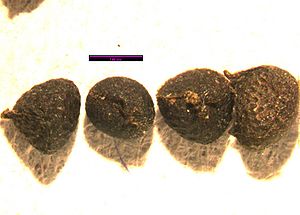Difference between revisions of "Sisyrichium idahoense"
(→Propagation) |
|||
| Line 28: | Line 28: | ||
Possible reclamation species in moister pockets in selected sites <ref>Winters, 2002</ref><br> | Possible reclamation species in moister pockets in selected sites <ref>Winters, 2002</ref><br> | ||
===Wildlife=== | ===Wildlife=== | ||
| − | Solitary bees of the family Megachilidae are mainly responsible for cross-pollination in natural populations <ref>Henderson, 1976</ref> <br> | + | Solitary bees of the family Megachilidae are mainly responsible for cross-pollination in natural populations <ref name="Henderson"/>Henderson, 1976</ref> <br> |
===Landscaping=== | ===Landscaping=== | ||
Mass-plant to create a showy display in a border or a rock garden <ref>Tenenbaum et al., 1994</ref><br> | Mass-plant to create a showy display in a border or a rock garden <ref>Tenenbaum et al., 1994</ref><br> | ||
| Line 35: | Line 35: | ||
==Propagation== | ==Propagation== | ||
===Seed Propagation=== | ===Seed Propagation=== | ||
| − | Flowers are protandrous, thereby promoting out-crossing and at the same time reducing the chances for self pollination. S. idahoensis is an octoploid species and often exhibits a lag of up to 24 hours between anther maturation and stigma receptivity | + | Flowers are protandrous, thereby promoting out-crossing and at the same time reducing the chances for self pollination. S. idahoensis is an octoploid species and often exhibits a lag of up to 24 hours between anther maturation and stigma receptivity <ref name="Henderson"/> |
===Outplanting Characteristics and Requirements=== | ===Outplanting Characteristics and Requirements=== | ||
Out-plant in the fall to take advantage of natural moisture or plant in spring and provide supplementary watering. Successfully self-seeds in situ. Can be successfully divided in situ in the spring by simply teasing plants apart and replanting the resulting clumps (R. Bridgeman, pers. comm.). | Out-plant in the fall to take advantage of natural moisture or plant in spring and provide supplementary watering. Successfully self-seeds in situ. Can be successfully divided in situ in the spring by simply teasing plants apart and replanting the resulting clumps (R. Bridgeman, pers. comm.). | ||
Revision as of 11:46, 16 April 2012
- Scientific Name: Sisyrichium idahoense
- Family: Iridaceae
- English Names: Blue-eyed grass, Idaho blue-eyed grass
- Other Names: Sisyrinchium angustifolium
Contents
Taxonomy
- Kingdom: Plantae
- (unranked): Angiosperms
- (unranked): Monocots
- Order: Asparagales
- Family: Iridaceae
- Subfamily: Iridoideae
- Tribe: Sisyrinchieae
- Genus: Sisyrinchium
- Species: S. idahoense
Description
Showy, tufted perennial to 40 cm tall; stems usually flattened and wing-margined. Leaves mostly basal, long (to 20 cm).and very narrow (< 2 mm broad). Flowers blue to purplish-blue often with a yellow "eye", small (about 2 cm across) and in a terminal cluster of one to five flowers above a pair of sheathing, leaf-like bracts. Fruits egg-shaped capsules to 6 mm long, with black seeds [1]
Bloom Period
May to July
Distribution
Habitat
Moist to wet grassy meadows, vernal seepage areas, marshes, roadside ditches; at low to middle elevations [1]
Uses
Site Rehabilitation
Possible reclamation species in moister pockets in selected sites [2]
Wildlife
Solitary bees of the family Megachilidae are mainly responsible for cross-pollination in natural populations [3]Henderson, 1976</ref>
Landscaping
Mass-plant to create a showy display in a border or a rock garden [4]
First Nations
Infusion of root given to children for diarrhea; Eaten as cooked greens for “regular bowels”; decoction of roots and stalks taken before morning meal for constipation; compound with plant taken for “summer complaint”; infusion of plant taken for stomach troubles and stomach worms; mixed with other greens and eaten.
Propagation
Seed Propagation
Flowers are protandrous, thereby promoting out-crossing and at the same time reducing the chances for self pollination. S. idahoensis is an octoploid species and often exhibits a lag of up to 24 hours between anther maturation and stigma receptivity [3]
Outplanting Characteristics and Requirements
Out-plant in the fall to take advantage of natural moisture or plant in spring and provide supplementary watering. Successfully self-seeds in situ. Can be successfully divided in situ in the spring by simply teasing plants apart and replanting the resulting clumps (R. Bridgeman, pers. comm.).

